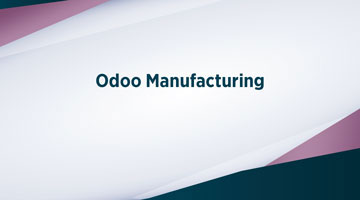Odoo Manufacturing

You probably already searched online if you should choose an ERP or MRP system. There are hundreds of blog articles explaining the differences. And hundreds IT companies telling why you should choose their product.
So, we’ll start by explaining the differences between each system. Then, we’ll tell you why the best manufacturing system is Odoo in our point view.
Features
- Manage Manufacturing orders
- Manage Work orders
- Manage Barcode
- Repair orders
- Plan manufacturing
- Manage Bill of Materials
- Organize work orders
- Work enter Capacity
- Record production
- Worksheets
- Work order steps
- Quality Alerts
- Quality Checks
- Overall Equipment Effectiveness Reports
- Cost analysis Reports
ERP and MRP
Their names may be similar, but what they do is different. ERP and MRP systems complement each other. It helped companies to be more accurate calculating required materials, quantities, and at what time they’re needed.
As the manufacturing industry grew, so did the complexity of operations. Later, a system that had a broader reach was needed. That’s how ERP came to be. A software capable of managing accounting, HR, marketing, CRM and more. But, ERP didn’t replace MRP. Today, you can buy MRP software on its own. This is a common practice among smaller manufacturers who don’t need a full ERP system.
MRP allows manufacturing businesses to be accurate when ordering materials. What they need, how much and when they need it.
MRP II is a more recent version of it. It includes scheduling, detailed capacity planning, shop floor control and other calculations. Businesses can analyse performance to get better efficiency or compare forecasts with actual data.
How to Configure Operations, BOM, Stock Rules, Warehouse and Routing in Odoo Manufacturing
Odoo an Open source ERP solution helps you to implement and customize Manufacturing ERP software for your business. Manufacturing module in Odoo manage all manufacturing related activities. In Odoo, custom manufacturing work orders are created with the help of work centers and routing concepts. Manufacturing in Odoo is more helpful for the production of a manufactured product or the product is built by some other products with different quantities.
Manufacturing in Odoo is more helpful for the production of manufactured product or the product is built by some other products with different quantities. The cosmetic products are a good example, in that production uses some raw material.
- In Odoo manufacturing process is managed in Manufacturing module, so first we have to install that module in our db, after installing another routing option (manufacture) is added in the product form.
- There are 3 options in product form for routing, Buy, manufacture and make to order.
- If you work with no stock, or with minimum stock rules, it is better to use the Make To Order route.
- Combine it with the route Buy or Manufacture, and it will trigger automatically the purchase order or the Manufacturing Order when your products are out-of-stock.
- The manufacturing orders are created under Manufacturing → Operations → Manufacturing Orders(MO). Before that, we have to define the bill of materials that used for the production of that final product.
- The material used for manufacturing are bill of material, that are configured in the Manufacturing → Master Data → Bill of Materials as shown in the figure.
Configuration of Work Center
Firstly, you have to install the manufacturing module in your database. At that time, you to enable the option of the work center.
Go to Manufacturing → Master Data → Work Centers and click on the Create button
Now you can fill the following fields under the General Information Tab. You can add performance indices like time efficiency factor, capacity, OEE target, cost per hour, etc. from General Information Tab.
Configuration of Routing
In the manufacturing module, routing scan be used to specify the manufacturing operations to be done in work centers to develop a certain product. Every product has its own routes. It is not a single step process, the manufacturing process may consist of many work centers and any work centers have its own processes and process time. At that time, you can set the route of the specific manufacturing process.
Routing completely depends on the manufacturing company process. A few companies have the same type of manufacturing process. Then you can create only one type of routing. A few companies have a distinct manufacturing process, Then you can create multiple routing.
Go to Manufacturing → Master data → Routing
Now you can click on routing button to create new routing in your database.
At that time you can fill the following field like name of the routing, company name production location and add work operation there. Whenever you want to add a work operation, then click on adds a line button.
Now you can fill the following fields like operation name, work center, and duration computation. There are two options available in duration computation: compute based on real-time and set duration manually, and also an option for setting default duration. Then fill the next operation field and click on the Save button.
Routing can be defined directly in a bill of materials or through the menu Manufacturing → Products → Routings.
Subsequent, you can select the created route in BOM of a product, so the product will follow that particular route during the manufacturing process.
